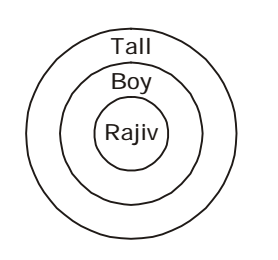Syllogism
Direction: Three statements are given followed by three Conclusions I, II and III. You have to consider the three statements to be true even if they seem to be at variance from commonly known facts. You have to decide which of the given Conclusions, if any, follow from the given statements.
- Statements:
a. Mary said, “Ann and I both have cats.”
b. Ann said, “I don’t have a cat.”
c. Mary always tells the truth, but Ann sometimes lies.
Conclusions:
I. Ann has a cat.
II. Mary has a cat.
III. Ann is lying.
-
View Hint View Answer Discuss in Forum
Mary always tells the truth. Therefore, both Mary and Ann have cats.
Correct Option: C
Mary always tells the truth. Therefore, both Mary and Ann have cats. Clearly, Ann is lying. Thus, all the Conclusions I, II and III follow.
Direction: Consider the given statement(s) to be true and decide which of the given conclusions/assumptions can definitely be drawn from the given statement(s).
- Statements:
1. All stenographers are lazy.
2. Some men are stenographers.
Conclusions:
I. All lazy people are men.
II. Some men are lazy.
-
View Hint View Answer Discuss in Forum
First Premise is Universal Affirmative (A-type).
Second Premise is Particular Affirmative (I-type).
Some men are stenographers. ↔ All stenographers are lazy.Correct Option: B
First Premise is Universal Affirmative (A-type).
Second Premise is Particular Affirmative (I-type).
Some men are stenographers. ↔ All stenographers are lazy.
I + A ⇒ I-type of Conclusion “Some men are lazy”.
This is Conclusion II.
Direction: Below some statements are given, followed by some conclusions. You have to consider the statements to be true even if they seem to be at variance from commonly known facts. You have to decide which of the given conclusions, if any, follow from the given statements.
- Statements:
Some pens are pencils.
Some pencils are erasers.
Some erasers are sharpeners.
Conclusions:
I. Some sharpeners are pens.
II. Some pencils are sharpeners.
III. Some erasers are pens.
-
View Hint View Answer Discuss in Forum
All the three Premises are particular (I–type).
Correct Option: A
All the three Premises are particular (I–type). No Conclusion follows from the two particular premises.
Direction: One or two statements are given followed by two conclusions, I and II. You have to consider the statement to be true, even if it seems to be at variance from commonly known facts. You are to decide which of the given conclusions/assumptions can definitely be drawn from the given statement. Indicate your answer.
- Statements:
All boys are tall.
Rajiv is a boy.
Conclusions:
I. Rajiv is tall.
II. Rajiv is not tall.
-
View Hint View Answer Discuss in Forum
Both the Premises are Universal Affirmative (A – type).
Rajiv is a boy. ↔ All boys are tall.Correct Option: A
Both the Premises are Universal Affirmative (A – type).
Rajiv is a boy. ↔ All boys are tall.
A + A ⇒ A-type of Conclusion “Rajiv is tall”.
This is Conclusion I.
Venn diagrams:
Direction: Consider the given statements to be true and decide which of the given Conclusions/assumptions can definitely be drawn from the given statements.
- Statements:
1. All elephants are men.
2. All men are socks.
Conclusions:
I. Some socks are elephants.
II. All elephants are socks.
-
View Hint View Answer Discuss in Forum
Both the Premises are Universal Affirmative (A–type).
All elephants are men. ↔ All men are socks.Correct Option: C
Both the Premises are Universal Affirmative (A–type).
All elephants are men. ↔ All men are socks.
A + A ⇒ A–type of Conclusion “All elephants are socks.”
This is Conclusion II.
Conclusion I is the Converse of it.

